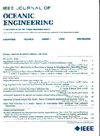现场吸入过滤采样器与数百膜深海悬浮液
IF 5.3
2区 工程技术
Q1 ENGINEERING, CIVIL
引用次数: 0
摘要
深海微生物数量丰富,种类繁多,在工程应用、医学用途和解释生命起源方面具有潜力。为了获得大量的长期时间序列样品,提出了一种原位吸滤采样器,该采样器可通过滚轮缠绕360多个有效直径为60 mm的过滤膜。为了避免过滤膜与海水相互作用,提出了多层过滤膜结构。根据各种测试结果,最终选择了PET(聚对苯二甲酸乙二醇酯,厚度为0.2 mm)-PES(聚醚砜,孔径分别为0.45和1 μm)和PET(厚度为0.2 mm)-PTFE(聚四氟乙烯,孔径为0.22 μm)多层过滤膜结构。这些组合不仅可以保证更好的透水性能,而且可以保证更好的强度。基于过滤膜透水试验数据,利用有限元软件ANSYS Fluent研究了过滤室内悬浮物的运动和聚集规律。悬浮液中的浓度峰值随粒径的增大和滤膜孔径的减小而增大。最后,该装置在45 MPa高压室中成功运行。此外,在海上试验中,采样器成功地在甲烷泄漏区域获得了原位悬浮液。本文章由计算机程序翻译,如有差异,请以英文原文为准。
In Situ Suction Filtration Sampler With Hundreds of Membranes for Deep-Sea Suspensions
Deep-sea microorganisms are highly abundant and diverse and have potential for engineering applications, medicinal uses, and explaining the origin of life. To obtain many long-term time series samples, an in situ suction filtration sampler was proposed, which can wind more than 360 filter membranes with an effective diameter of 60 mm through rollers. A multilayer filter membrane structure was proposed to avoid interactions between filter membranes and seawater. Based on various test results, multilayer filter membrane structures of PET (polyethylene glycol terephthalate, thickness of 0.2 mm)-PES (polyethersulfone, pore size of 0.45 and 1 μm) and PET (thickness of 0.2 mm)-PTFE (polytetrafluoroethylene, pore size of 0.22 μm) were finally selected. These combinations can ensure not only better water-permeability performance but also better strength. Furthermore, based on the data from the water-permeability test of the filtration membranes, the finite element software ANSYS Fluent was used to study the movement and aggregation laws of suspensions in the filtration chamber. The peak concentration in the suspension increases with increasing particle size and decreasing filter membrane pore size. Finally, the device was successfully operated in a 45 MPa high-pressure chamber. Additionally, in sea trials, the sampler successfully obtained an in situ suspension in a methane leakage area.
求助全文
通过发布文献求助,成功后即可免费获取论文全文。
去求助
来源期刊

IEEE Journal of Oceanic Engineering
工程技术-工程:大洋
CiteScore
9.60
自引率
12.20%
发文量
86
审稿时长
12 months
期刊介绍:
The IEEE Journal of Oceanic Engineering (ISSN 0364-9059) is the online-only quarterly publication of the IEEE Oceanic Engineering Society (IEEE OES). The scope of the Journal is the field of interest of the IEEE OES, which encompasses all aspects of science, engineering, and technology that address research, development, and operations pertaining to all bodies of water. This includes the creation of new capabilities and technologies from concept design through prototypes, testing, and operational systems to sense, explore, understand, develop, use, and responsibly manage natural resources.
 求助内容:
求助内容: 应助结果提醒方式:
应助结果提醒方式:


